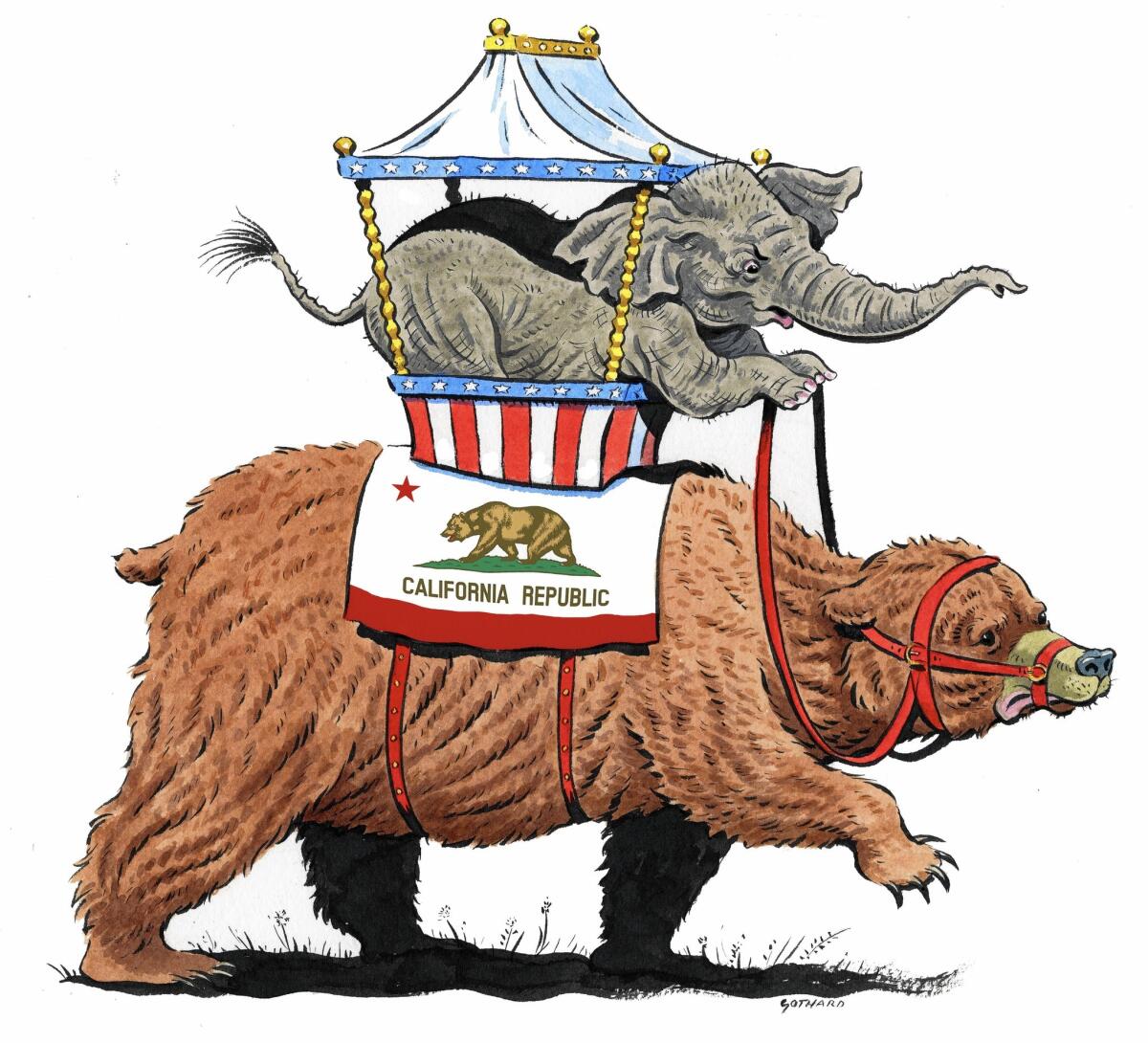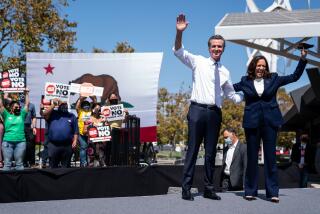Op-Ed: The GOP’s California roots

- Share via
Picture this: Republican leaders and wealthy businessmen argue that the president is a demagogue who panders to the most shiftless members of American society; that he seeks to destroy the Constitution, particularly the Bill of Rights; that he wants to incite class warfare, undermine individualism and redistribute wealth. They whisper that he’s not truly American, that he might secretly be guided by a foreign ideology.
Although this description may bring to mind Ted Cruz or Donald Trump talking about President Obama on the 2016 campaign trail, such overheated rhetoric is also characteristic of the Great Depression. Indeed, the ideas and strategies of the current Republican Party were born in the 1930s. Perhaps more surprising, they have their roots in California, now one of the most liberal states in the nation.
The Great Depression revolutionized the way that Americans related to their government, including how conservatives perceived and responded to federal authority. Before Franklin Delano Roosevelt took office in 1933, conservative businessmen typically supported centralized authority. The federal government, after all, levied tariffs to protect their industries and built infrastructure so they could ship their goods.
The Great Depression revolutionized the way that Americans related to their government, including how conservatives perceived and responded to federal authority.
More important, before the 1930s Washington helped businessmen control workers. Throughout the end of the 19th and the beginning of the 20th centuries, federal officials looked the other way when employers hired thugs to attack strikers. In some instances, they even sent U.S. troops to end job actions. Conservatives mostly understood that a strong government was a great tool to defend property rights; they feared anarchy, not tyranny.
Everything changed when soaring unemployment helped put Roosevelt in office. To stimulate economic recovery, Roosevelt’s administration took the nation off the gold standard, regulated banking and investing, and put millions of jobless Americans to work building roads, schools and bridges.
At first, many businessmen supported New Deal policies. In California, for instance, corporate agribusinesses favored Roosevelt’s farm subsidies and his commitment to build dams and irrigation canals.
But corporate leaders despised Roosevelt’s labor policies. Roosevelt understood that the economy couldn’t function if workers were too poor to buy goods. Accordingly, to help raise wages, the Roosevelt administration empowered laborers by guaranteeing their right to join unions. The 1933 National Industrial Recovery Act said that workers “shall have the right to organize and bargain collectively through representatives of their own choosing.”
Courting Southern lawmakers who did not want sharecroppers or maids to join a union, the Roosevelt administration deliberately omitted farm and domestic workers from most New Deal programs. These laborers, however, were oblivious to their exclusion. In 1933, unaware that they had been cast to the margins of the New Deal, they began demanding union recognition and higher wages from their bosses. When their employers refused, these farmworkers went on strike. The biggest agricultural labor action in U.S. history rocked the San Joaquin Valley in 1933 when growers refused to raise cotton pickers’ wages to the national minimum wage of 25 cents an hour. More than 18,000 agricultural workers walked off the fields in protest. Another strike, this time involving thousands of vegetable and melon workers, hit Imperial Valley in early 1934.
The walkouts threatened California growers who had previously enjoyed largely unfettered control over their workforce. Farmers had hired mainly Mexican immigrants to pick their crops — people unlikely to unionize and unable to vote. But in 1933, American Communists organized these seemingly tractable workers.
Roosevelt’s aides neither encouraged the strikes nor tolerated the growers’ violent efforts to break them. When federal mediators arrived in California’s fields, they proposed to broker a compromise solution to the disputes. One mediator threatened to withhold agricultural subsidies from the growers unless they agreed to a settlement that would amount to paying the workers a few cents more an hour.
Such evenhandedness infuriated the growers. “By all that is fair and just, have the American farmers no rights over Communists and aliens?” asked a San Joaquin Valley newspaper.
Like their workers, the growers organized. They formed a group called the Associated Farmers, which lobbied state and local prosecutors to go after Communist union leaders for violating the state’s sedition law. Then they moved against the New Deal itself. Conservative organizations used sophisticated, Hollywood-inspired advertising to convince middle-class Californians that the New Deal represented a Communist attack on private property, organized religion and the traditional family.
“Our national government today is honeycombed through and through with Communists and nothing seems to be done about it,” the Los Angeles radio broadcaster Martin Luther Thomas told a huge crowd of Christian activists in 1936. Former President Hoover maintained that Roosevelt was leading a “march toward Moscow.”
To liberals at the time, the conservatives’ rhetoric seemed disingenuous. They couldn’t possibly think that Roosevelt was a Communist, could they? But many of the state’s business leaders sincerely believed that, at a minimum, Roosevelt was making the political arena safe for un-American ideas. As Los Angeles utilities executive William Mullendore explained to a friend, the president had “used his high office to lift out of the gutter and on to a plane of respectability the basic ideas of Socialism and Communism.”
Mullendore worked with Hoover to mobilize businessmen across the United States against the New Deal. “These subversive ideas and doctrines,” he vowed, “must be stamped out in the quarter from which they emanate and where they do the most harm — that is, in the capital of the nation.” He and his colleagues in the conservative movement attacked the president’s policies by equating them with treason.
As the New Deal progressed, conservatives articulated their opposition to a strong state and, little by little, developed a coherent limited-government philosophy. Government was not a helpful partner in building markets and managing labor, as previously believed; it was a potentially totalitarian force that had to be contained.
This insight, gleaned in the fields of California, still animates the Republican Party today.
Kathryn S. Olmsted is professor and chairwoman of the history department at UC Davis. She is the author of “Right Out of California: The 1930s and the Big Business Roots of Modern Conservatism.”
Follow the Opinion section on Twitter @latimesopinion and Facebook
More to Read
A cure for the common opinion
Get thought-provoking perspectives with our weekly newsletter.
You may occasionally receive promotional content from the Los Angeles Times.






